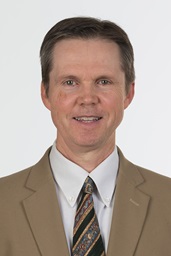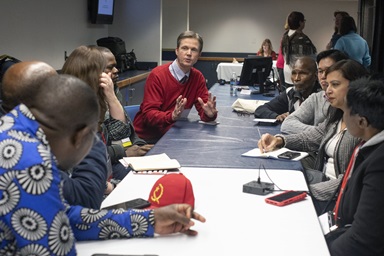During World War II, 20,000 bombs were dropped on the suburb of Oranienburg.
Six decades later, as many as 10 percent or 2,000 of those bombs still lie unexploded beneath this community. No one knows where they are. When one is discovered, everyone in the area has to evacuate.
The bright yellow United Methodist Church in the Container in the White City section of town is one of the places where residents can go until it is safe to return to their homes.
“We are still finding bombs, many with chemical detonators,” explained Oranienburg’s mayor, Hans Joachim Laesicke. “The latest one was just one kilometer away.”
Airplane manufacturing and German military presence made Oranienburg an Allied bombing target during World War II. The White City area of the town — so called because of its row after row of white apartment blocks — first housed the airplane construction workers and then military personnel during the war.
“The bombs are a constant danger,” said reporter Heiko Hohenhaus of the Märkische Allegemain newspaper. Hohenhaus explained that White City faced many other problems after the war as well. During the communist period when Oranienburg was part of East Germany, Russian officers were housed in White City. The area was almost like a sealed compound. When the Russians finally left in 1994, they took everything — literally including the kitchen sink — leaving the apartment buildings in ruins.
Eventually the buildings were renovated, but even today, Hohenhaus says basic infrastructure in White City is lacking. “There are still not many shops, and there are no clubs for young people,” he observed.
Hoping to address some of the needs, the Church in the Container adopted children and young people as its major ministry focus. The church has a full-time youth project director and provides a safe place for teenagers and children to meet and find support.
Oranienburg lives with another infamous distinction. It was place where the first of the notorious Nazi concentration camps, Sachsenhausen, was built. In the 1930s and 40s, thousands were imprisoned here by the German SS and died. When the Russians took over the camp after the war, Sachsenhausen became part of the Soviet gulag prison system with 60,000 imprisoned there, of whom 12,000 perished.
Today on the Sachsenhausen site is a memorial and a museum, which tourist brochures describe as a place of “living confrontation with the terror of Nazism” and “a place to meet and seek reconciliation among many people of different nationalities.”
The fallout from this bleak and complex legacy has left deep physical and spiritual scars on the community. Many who moved into White City after the Russians left were low-income families. Alcohol and drug addiction are common among both young people and adults. Gangs as well as extreme right- and left-wing political groups vie for influence.
Hannah Franzke, Youth Project director for the Church in the Container, grew up in Oranienburg. She understands the challenges of living with White City’s past and present.
“Of course there are difficulties,” she said. Not long ago, she had to break up a fight that was brewing between young people at the container church and boys from a left wing gang who were hanging-out in a nearby derelict building.
“They said they were ‘anti-Christian’,” Franzke told United Methodist News Service. “I asked them if they had ever talked to any Christians and they said ‘no.’ And that’s how a conversation begins.”
Laesicke said the cooperation between government and the church on the project is important. The Church in the Container’s pastor, the Rev. Heinrich Meinhardt, actively sought the mayor’s input when the congregation was planning the new church.
“It is important that the church doesn’t step back and is willing to deal with these problems,” Laesicke explained.
Franzke, Meinhardt and other United Methodists in Oranienburg have no intention of stepping back. In fact, plans are under way to construct a multipurpose building that can better serve the spiritual and social needs of this community.
“We are praying that good news is coming into the lives of people here,” Franzke said.
More information on the Church in the Container is available by writing to [email protected] or [email protected].
*LaCamera is a UMNS correspondent based in England.
News media contact: Linda Bloom, New York, (646) 369-3759 or [email protected].
Like what you're reading? Support the ministry of UM News! Your support ensures the latest denominational news, dynamic stories and informative articles will continue to connect our global community. Make a tax-deductible donation at ResourceUMC.org/GiveUMCom.



